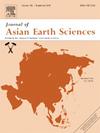中亚费尔干纳盆地中始新世环境条件和生物地理背景的新认识:微古生物学方法
IF 2.4
3区 地球科学
Q2 GEOSCIENCES, MULTIDISCIPLINARY
引用次数: 0
摘要
费尔干纳盆地是中亚最大的盆地之一,位于特提斯地层和亚洲大陆之间,其中新世的变化对了解中亚向区域干旱化的过渡起着关键作用。该盆地的变化不仅造成了区域干旱化,而且影响了全球海洋环流和气候。本研究考察了突厥斯坦地层和里什坦地层中的微古生物群落,尤其是作为代用指标的有孔虫和浮游动物群。研究人员通过统计分析估算了微型动物的物种多样性、结构和组成,为了解微型动物在不同岩层和地层剖面中的分布情况提供了新的信息,并有助于古生态重建。该环境被解释为近岸沿海潮间带或高潮下带,其底质由低氧的表层下沉积物和富氧的底栖带表层生境组成。这项研究成果加深了对该地区的了解,提出费尔干纳盆地中始新世是一个复杂的配置领域,而不是以前所认为的海湾。本文章由计算机程序翻译,如有差异,请以英文原文为准。

New insights into the middle Eocene environmental conditions and biogeographic setting of the Fergana Basin (Central Asia): Micropaleontological approaches
The middle Eocene transformation of the Fergana Basin, one of the largest basins in Central Asia situated between the Peri-Tethys and the Asian continent, plays a key role in understanding the transition to regional aridification of Central Asia. The basin’s transformation not only contributed to regional aridification but also affected global ocean circulation and climate. This study examines the micropaleontological communities, especially foraminifera and ostracoda assemblages as proxies, within the Turkestan and Rishtan formations, which corresponding to the Lutetian and Bartonian stages of the middle Eocene, respectively. Statistical analyses were performed to estimate species diversity, structure, and composition of the microfauna, shedding new light on their distribution across facies and stratigraphic profiles, and contributing to a paleoecological reconstruction. The environment is interpreted as a nearshore coastal intertidal or high subtidal zone with a substrate consisting of low-oxygen subsurface sediments and well-oxygenated benthic zone surface habitats. The results of this research provide a deeper understanding of the area, proposing that the middle Eocene of Fergana Basin was a complex configurated realm rather than a gulf, as previously recognized.
求助全文
通过发布文献求助,成功后即可免费获取论文全文。
去求助
来源期刊

Journal of Asian Earth Sciences
地学-地球科学综合
CiteScore
5.90
自引率
10.00%
发文量
324
审稿时长
71 days
期刊介绍:
Journal of Asian Earth Sciences has an open access mirror journal Journal of Asian Earth Sciences: X, sharing the same aims and scope, editorial team, submission system and rigorous peer review.
The Journal of Asian Earth Sciences is an international interdisciplinary journal devoted to all aspects of research related to the solid Earth Sciences of Asia. The Journal publishes high quality, peer-reviewed scientific papers on the regional geology, tectonics, geochemistry and geophysics of Asia. It will be devoted primarily to research papers but short communications relating to new developments of broad interest, reviews and book reviews will also be included. Papers must have international appeal and should present work of more than local significance.
The scope includes deep processes of the Asian continent and its adjacent oceans; seismology and earthquakes; orogeny, magmatism, metamorphism and volcanism; growth, deformation and destruction of the Asian crust; crust-mantle interaction; evolution of life (early life, biostratigraphy, biogeography and mass-extinction); fluids, fluxes and reservoirs of mineral and energy resources; surface processes (weathering, erosion, transport and deposition of sediments) and resulting geomorphology; and the response of the Earth to global climate change as viewed within the Asian continent and surrounding oceans.
 求助内容:
求助内容: 应助结果提醒方式:
应助结果提醒方式:


